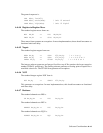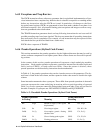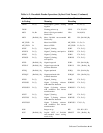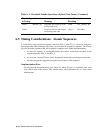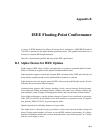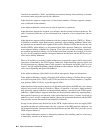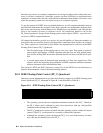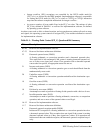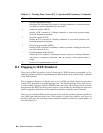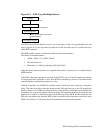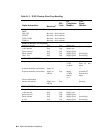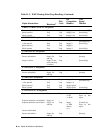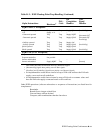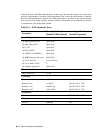
IEEE Floating-Point Conformance B–5
• Integer overflow (IOV) exceptions are controlled by the INVE enable mask bit
(FP_C<1>), as allowed by the IEEE standard. Implementation software is responsible
for setting the INVS status bit (FP_C<17>) when a CVTTQ or CVTQL instruction
traps into the software completion mechanism for integer overflow .
• At process creation, all trap enable flags in the FP_C are clear. The settings of other
FP_C bits, defined in Table B–1 as reserved for implementation software, are defined
by operating system software.
At other events such as forks or thread creation, and at asynchronous routine calls such as traps
and signals, the operating system controls all assigned FP_C bits and those defined as reserved
for implementation software.
Table B–1: Floating-Point Control (FP_C) Quadword Bit Summary
Bit Description
63–48 Reserved for implementation software.
47–23 Reserved for future architecture definition.
22 Denormal operand status (DNOS)
A floating arithmetic or conversion operation used a denormal operand value.
This status field is left unchanged if the system is treating denormal operand val-
ues as if they were signed zero values. If an operation with a denormal operand
causes other exceptions, all appropriate status bits are set.
21 Inexact result status (INES)
A floating arithmetic or conversion operation gave a result that differed from the
mathematically exact result.
20 Underflow status (UNFS)
A floating arithmetic or conversion operation underflowed the destination expo-
nent.
19 Overflow status (OVFS)
A floating arithmetic or conversion operation overflowed the destination expo-
nent.
18 Division by zero status (DZES)
An attempt was made to perform a floating divide operation with a divisor of zero.
17 Invalid operation status (INVS)
An attempt was made to perform a floating arithmetic, conversion, or comparison
operation, and one or more of the operand values were illegal.
16–12 Reserved for implementation software.
11–7 Reserved for future architecture definition.
6 Denormal operand exception enable (DNOE)
Initiate an INV exception if a floating arithmetic or conversion operation involves
a denormal operand value. This exception does not signal if the system is treating
denormal operand values as if they were signed zero values. If an operation can
initiate more than one enabled exception, the denormal operand exception has pri-
ority.



